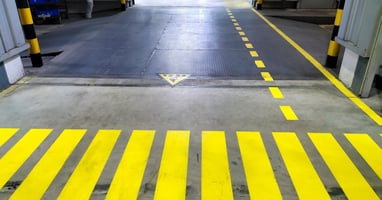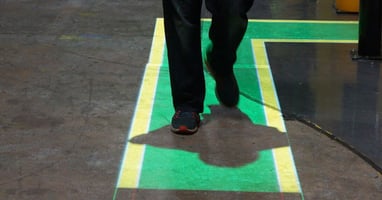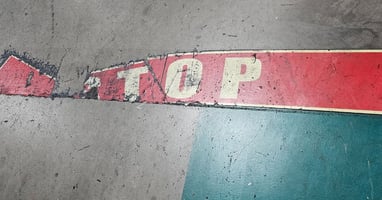With heavy machinery, a plethora of inventory, and a quick-paced environment, employees are at risk...
Strategies To Reduce Warehouse Slip-and-Fall Accidents

A safe workplace is a productive workplace. Slips, trips, and falls are among the most common and costly causes of workplace injuries. According to the National Safety Council, these incidents resulted in a total of 800,520 nonfatal injuries in 2022.
To effectively manage safety risks, you need to take a proactive, multifaceted approach. This guide provides practical, actionable strategies to help you reduce warehouse slip-and-fall accidents. By focusing on everything from proper housekeeping to advanced safety technology, you can create a safer, more secure facility for everyone.
Implement a Proactive Housekeeping Schedule
The foundation of a safe warehouse is cleanliness and organization. Cluttered aisles, stray equipment, and unmanaged spills create immediate hazards that can lead to serious accidents. Follow these steps to establish a consistent and proactive housekeeping schedule:
- Assign cleaning responsibilities: Create a clear plan that assigns specific cleaning tasks to individuals or teams, covering daily, weekly, and monthly duties.
- Focus on daily cleaning: This includes sweeping floors, clearing walkways of debris and cords, and cleaning up spills.
- Organize storage areas: Set up designated zones for tools, equipment, and materials. Return items to their proper places, and use clear signage to mark these areas.
- Schedule weekly and monthly tasks: Plan for deeper cleaning, like removing grime or grease from floors and inspecting storage racks for stability.
- Conduct regular inspections: Use a daily checklist for supervisors to identify and address potential hazards during walkthroughs.
- Make housekeeping a team effort: Encourage shared responsibilities to build a culture where everyone contributes to a safe and organized workplace.

Install Functional Lighting Throughout the Facility
Poor visibility is a contributor to warehouse accidents. Inadequately lit areas can obscure hazards on the floor, making it difficult for employees to judge distances accurately and increasing the likelihood of trips and falls, especially in crowded or fast-paced environments.
Lighting Audit and Upgrades
Conduct a thorough audit of your entire warehouse to identify areas with insufficient lighting. Pay close attention to transition zones, such as loading docks, stairwells, and the spaces between storage racks. These areas commonly have fluctuating light levels and can pose a greater risk.
Additionally, upgrade outdated lighting systems to modern, energy-efficient solutions like LEDs, which provide brighter, more consistent illumination and can reduce operational costs. Make sure to position light fixtures strategically to eliminate shadows and dark corners where hazards might go unnoticed.
Routine Maintenance
A single malfunctioning light can create a dangerous blind spot. Establish a maintenance schedule to clean fixtures and replace burnt-out bulbs promptly. By investing in and maintaining a comprehensive lighting system, you improve visibility and give your employees the clarity they need to navigate the workspace safely.
Invest in High-Traction Flooring and Mats
Your approach to flooring can prevent or cause slips. High-traffic areas, especially those prone to moisture, oil, or other liquids, require surfaces that provide adequate grip. Investing in the right flooring and anti-slip solutions can drastically reduce the number of fall-related incidents.
Flooring Materials
When selecting flooring, consider materials with a high coefficient of friction, which indicates their resistance to slipping. Options include textured concrete, resinous flooring with anti-slip additives, or specialized industrial floor coatings. For existing floors, applying anti-slip paint or tape can be a cost-effective way to increase traction in targeted high-risk zones.
Anti-Slip Mats
In areas where spills are common or at entrances where employees may track in water or snow, place high-quality anti-slip mats. These mats should have beveled edges to prevent tripping and a nonslip backing to keep them securely in place.
Regularly inspect and clean these mats to ensure they remain effective. A worn-out or saturated mat can become a hazard itself. By carefully selecting and maintaining your flooring surfaces, you create a more stable and secure foundation for your entire operation.
Use LED Walkways
Clearly defining pedestrian and vehicle pathways is essential for preventing collisions and related accidents. While traditional methods like painted lines and adhesive tape serve this purpose, they often fall short in demanding industrial settings. These markings can wear down, fade, or become obscured by dirt and grime, quickly losing their effectiveness in high-traffic areas.
To address this challenge, consider implementing virtual safety LED walkways. This technology uses durable projectors to cast bright, highly visible lines onto the floor to create clear and unmistakable traffic lanes. Unlike paint or tape, projected lines do not fade. The vibrant light grabs employees’ attention, effectively separating pedestrian walkways from forklift and other vehicle pathways.
In addition to the safety benefits, virtual walkways don’t demand repeated costs over time. The frequent maintenance, labor, and material costs associated with repainting lines disappear, as the initial installation of the digital walkway provides long-lasting visibility.

Provide and Enforce Use of Proper Footwear
The shoes your employees wear often serve as their first line of defense against slips and falls. Standard footwear often lacks the necessary grip for industrial surfaces, especially when they are wet or oily. Mandating the use of appropriate, slip-resistant footwear is a fundamental component of any comprehensive warehouse safety program.
Selecting the Right Footwear
Work with a safety supplier to identify footwear that is best suited for your specific work environment. Look for shoes with high-traction outsoles designed to channel liquids away and maintain contact with the floor. The sole material and tread pattern are key factors in determining a shoe’s slip resistance. In addition to grip, consider other protective features such as steel toes for impact protection or puncture-resistant soles if sharp objects are a concern.
Implement a Footwear Policy
Develop a clear, consistent policy that requires all employees and visitors entering the warehouse floor to wear approved safety footwear. You may want to consider providing a footwear allowance or subsidy to employees to help remove any financial barriers. Also, regular reminders and checks can help reinforce the importance of this policy and guarantee everyone on your team is properly equipped to stay on their feet.
Fortify Your Safety Strategy
Reducing warehouse slip-and-fall accidents requires a dedicated and continuous effort. By implementing a combination of these strategies, you can build a robust safety culture. A safer warehouse is a more compliant and productive one, plus it demonstrates a deep commitment to your most valuable asset: your people.
If you are ready to enhance the safety of your facility, Logimate has the expertise and products you need. Contact us today to learn more about how our safety solutions can protect your team and strengthen your business.




